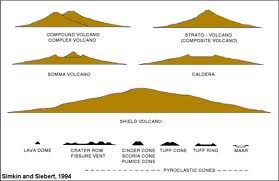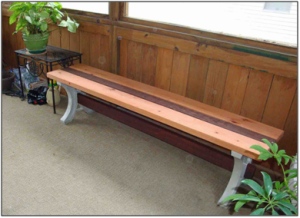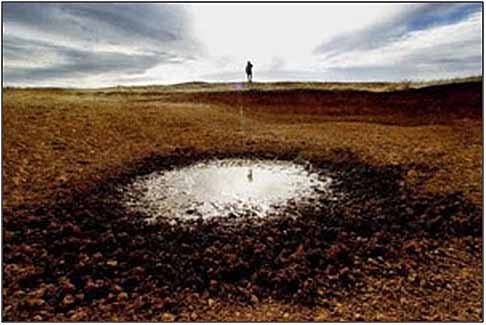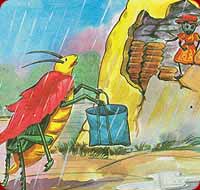(News & Editorial/A guide to cushioning system collapse)
A. Crisis Reality: “Within An Hour the Stores Were Emptied”

22 January 2014, The Daily Sheeple, by Mac Slavo at SHTFPlan.com
Pasted from: http://www.thedailysheeple.com/crisis-reality-within-an-hour-the-stores-were-emptied_012014
When toxic chemicals spilled into the Elk River in Charleston, West Virginia a couple of weeks ago we got another glimpse into what the world might look like in the aftermath of a major, widespread disaster.
There were several lessons we can take from this regional emergency and all of them are pretty much exactly what you might expect would happen when the water supplies for 300,000 people become suddenly unavailable.
Lesson #1: There will be immediate panic
Studies have suggested that the average person has about three days worth of food in their pantry, after which they would be left with no choice but to scrounge for scraps once their food stores run out. We saw this scenario play out after Hurricane Sandy, when thousands of unprepared people lined up at National Guard operated FEMA tents and temporary camps. That’s what happens when there’s no food.
With water, however, it’s a whole different matter.
Food we can do without for weeks, but lack of water will kill us in a very short time. The events following the Charleston chemical spill highlight just how critical fresh water is to maintaining stability.
A reader at The Prepper Journal web site shared his firsthand account of the events as they played out. In a situation where water supplies are poisoned, whether by accident or on purpose, the anatomy of a breakdown accelerates significantly from three days to mere minutes:
Just yesterday that ban was lifted, but what if this had happened in your town? Would you be able to live comfortably with no water from the tap for 5 days? The news reports that I read stated that there was plenty of water and the stores never ran out. That is in direct contradiction to what Steve tells me:
Immediately after the announcement, the stores in the area were rushed for any bottled water products. Within an hour the stores were emptied. Do not let anyone tell you that everything was nice, peaceful and everyone conducted themselves gracefully. There were fist fights and scuffles for the last of the water.
After the order was issued no one could give any answers as to when drinkable water would be available. Those with water were either hording it or selling it at enormous prices.
48 hours after the ban, water began to be distributed to the everyday person. Hospitals and nursing homes received the first shipments. By the way the hospitals (except one) were not taking any new patients). If you got hurt or injured you were on your own or had to travel an hour away for treatment.
What if the spill was more serious or the supply of water non-existent? Would you have enough water on hand and the means to disinfect new sources to take care of your family? It is news like this that illustrates for anyone paying attention the importance of storing water.
If you live an area affected by a water supply contamination and have no water reserves, this report suggests that you have less than an hour to stock up. And during that hour there will be panic with the potential for violence being highly probable.
Lesson #2: Security forces will be deployed to maintain order This is a no-brainer, but nonetheless worthy of mention.
We saw it after Hurricanes Sandy and Katrina – thousands of troops and militarized police deployed to prevent looting and rioting. The fact is that when the water and food run out people will be left with no choice but to rob and pillage. It becomes a matter of survival. Crowds will unwaveringly stampede to get to the resources they need. They’ll stomp over you if you happen to fall on the ground in a rush, because when the herd starts running nothing will stop it.
Imagine how these people will act when they are desperate for food food and water:
There is a reason the government has been preparing military contingency plans and simulations for events that include economic collapse or a massive natural disaster. They know what will happen if millions of people are left without critical supplies.
In Charleston, after water supplies started being delivered to grocery store chains, local government and the companies themselves brought on hired guards to keep the peace.
The Elk River event was limited in scope, affecting about 300,000 people in an isolated area, thus it was not that difficult of a situation to contain as FEMA and government could throw all of their resources and assets at the problem.
But imagine a scenario that involves multiple large metropolitan areas simultaneously in different regions of the country.
There are simply not enough personnel (or supplies) to respond to such a situation and maintain order.
Lesson #3: Despite hundreds of billions spent, the government is ill-prepared It took emergency responders five days to get water to the Super Dome in New Orleans following Hurricane Katrina.
Following Sandy, FEMA had enough food and water to provide the absolute basic necessities to about 50,000 people.
In Charleston it took at least two days to get water supplies moving.
If this were a massive catastrophe it could be weeks before help arrives.
The Federal Emergency Management Agency has itself warned that it is not equipped to handle large-scale emergencies. It’s for this reason that they strongly recommend a minimum two week supply of food and water.

Considering that the majority of Americans have maybe three days worth of supplies, how many millions of mouths would need to be fed three square meals a day if we experienced a multi-city event?
It was recently reported that FEMA has in its possession about 140 million “meals ready to eat.”
In 2011 a FEMA/DHS organized National Level exercise simulated an earthquake on the New Madrid Fault in the Mid West. The simulation revealed that 100,000 people would be killed almost immediately, and another 7 million would be displaced from their homes.
They would only have one place to go – government managed FEMA camps. Those seven million people eating just two MRE’s per day would consume FEMA’s entire emergency food reserve within 10 days.
Then what?
You probably already know the answer.
Prepare now, because the last place you want to be in is in the midst of crisis-driven panic.
.
B. Report: Supplier Survey & Trend Analysis of Preparedness and Resiliency Provisions
30 Sep 2012, learntoprepare.com, by Denis Korn
Pasted from: http://learntoprepare.com/2012/09/report-supplier-survey-trend-analysis-of-preparedness-and-resiliency-provisions/
Here is my perspective on current trends relating to food products for shelf stable food reserves and resiliency provisions in general.
In the 37 years I have been in the natural foods, outdoor recreation and emergency preparedness industries as a retailer and manufacturer, I have experienced a number of fluctuations and factors that have influenced the availability and pricing of foods and supplies for preparedness. A number of current factors and converging events are affecting the preparedness marketplace today and potentially in the near future.
In addition to my own present-day observations and experience as a retailer of food reserves and preparedness products, I have very recently surveyed a number of suppliers, processors and manufacturers for their assessment of current conditions in the marketplace.
Here are my appraisals, reports, and insights regarding the state of the industry:
- The numerous and diverse potential scenarios associated with emergency and disaster preparedness is so pervasive in contemporary culture, that a broad spectrum of citizens have begun to take some form of action. Others are acutely aware of the probable dangers and are waiting for a significant triggering event to act.
 If a serious event were to occur, fence sitters and those who have done nothing to prepare would overwhelm preparedness suppliers, manufacturers and normal outlets. Products will be sold out or long lead times will prevail. The nature of the triggering events will determine the availability of preparedness supplies for both the short and long terms.
If a serious event were to occur, fence sitters and those who have done nothing to prepare would overwhelm preparedness suppliers, manufacturers and normal outlets. Products will be sold out or long lead times will prevail. The nature of the triggering events will determine the availability of preparedness supplies for both the short and long terms.- Preparedness niche companies and their suppliers have a limited supply of goods on hand during normal business activity. At all levels of the supply chain there is a restricted amount of products available. Y2K, hurricanes, international disasters have all been testaments to disruptions in certain product availability. A wide spread and prolonged emergency will have a devastating effect on the availability of goods and services. This is especially true of specialty food processors.
- The main stream media will not accurately depict the real state of affairs regarding the current conditions in our society. This relates to politics, the economy, financial issues, government action and inaction, weather effects and anything that would be valuable for citizens to know so that they can prepare in advance for shortages. Information is significantly manipulated, controlled and fabricated. This includes what you hear and what you don’t hear.
- The current drought has had some effect on food prices and availability but not a catastrophic one. The increases in costs have already been factored in as it relates to commodity futures. Corn, soy beans and wheat were the crops most affected by the drought, as was potatoes and to a smaller extent other vegetables and fruits.

- A record corn crop was initially anticipated, so the effect of the drought could have been worse. NOTE: 40% of the corn crop goes for ethanol.
- Currently the price of most beans has dropped some due to good yields in North Dakota where 2/3 of the nation’s beans are grown. Availability of beans and other grains is good.
- Rice prices and availability is stable.
- Freeze dried food processors are very busy and are experiencing an increasing demand for fruit and vegetables from non preparedness manufacturers. This is causing shortages in some products. The drought has not substantially affected fruit and vegetables.
- There has been a shortage in some “ready” or “no cooking required” ingredients that are necessary for entrée and blended recipes. Many of these ingredients use non freeze drying technology to enable a no cooking requirement.
- Quality domestic food ingredients are becoming more difficult to source. It is essential that consumers do diligent research to establish trust with reputable manufacturers. Many current preparedness food packers have succumbed to using lower quality imported and processed foods.
- Currently, other vital preparedness provisions – electronics, medical, tools, water filters and such, are in adequate supply. Last year at this time there were shortages.
- Prices have risen in many sectors due to a multitude of factors such as transportation, packaging (paper prices have seen a steep increase), cost of benefits to employees, fuel, raw materials, regulations unfavorable to small business and lack of credit. Prices are expected to continue to rise, and with any new detrimental financial event they will rise dramatically.
- As shortages continue lead times for fulfillment will increase. I see this currently occurring.
- The current debilitating state of our nation and the attitudes of despair of our citizens are unprecedented in my lifetime.
- I and others see a substantial spike in demand for preparedness food and supplies from possibly right before to definitely after the November election. Negative reaction to the outcome of the election will be momentous – no matter who wins. We will soon know how serious the reaction will be, what form it will take and what governmental actions will be executed.
Conclusion:
Currently food products – with increasing lead times – and other supplies are available. However, there are a multitude of very volatile factors that could trigger a substantial increase in demand of preparedness supplies. A very difficult question to answer, although it discussed frequently is: How will a crisis effect fulfillment of essential goods and services?
During Y2K there were specific dates as to a potential problem, and specific remedies that could be addressed and possibly implemented. When citizens realized that problems had been addressed, demand for preparedness goods subsided. It was the unknown consequences of a potential computer calamity and the perceived resolution of those problems, which triggered the fluctuations in demand and supply.
The unknown consequences of the myriad of potentially devastating scenarios being discussed currently are not so easily resolved nor are the timing markers so easily recognized. There is so much uncertainty associated with current events that folks are either in denial or on edge waiting for a significant triggering event before they act. And when they do, preparedness suppliers, warehouse retailers and numerous provision dealers will be inundated.
I and numerous other observers of current events don’t ask if a catastrophe or serious events will happen – but when? Then we ask:
- 1. How long will it last?
- 2. How devastating will it be?
- 3. How will the population cope with a dramatic lifestyle change if scenarios are dramatic?
- 4. How many will be prepared?
- 5. What will those who are not prepared do, and who will they rely upon?
- 6. What repressive and draconian measures will the government implement?
- The unknown consequences of the myriad of potentially devastating scenarios being discussed currently are not so easily resolved nor are the timing markers so easily recognized. There is so much uncertainty associated with current events that folks are either in denial or on edge waiting for a significant triggering event before they act. And when they do, preparedness suppliers, warehouse retailers and numerous provision dealers will be inundated.
.
C. The #1 Preparedness Question – What’s Your Scenario? (Why?)
13 Oct 2012, learntoprepare.com, by Denis Korn
Pasted from: http://learntoprepare.com/2012/10/the-1-preparedness-question-whats-your-scenario-why/
This is such an important question to answer when engaging in preparedness planning that I felt it necessary to examine it more carefully. It is the first question in my 12 Crucial Questions of Preparedness Planning, listed under 12 Foundational Articles for Preparedness Planning (as you can see I like the number 12).
Before I proceed with this topic I want to share some insights on the current state of fears and concerns I hear people discussing.
 It is no secret that the societal, financial and moral issues of our time are wreaking havoc on the lives of most Americans. While at each election, the parties proclaim their election to be the most important of the era, what we currently are experiencing is that this statement is finally true. Not that the outcome will necessarily change the fundamental problems underlying our society and its governance, but that the results will indicate how really difficult true transformation will be. I am very passionate about my concerns for our country and the future for my children and grandchildren. I have never seen such blatant in-your-face displays of revolt, rage and lying by those who are ignorant, self-serving and delusional (a strong word yet in my opinion accurate).
It is no secret that the societal, financial and moral issues of our time are wreaking havoc on the lives of most Americans. While at each election, the parties proclaim their election to be the most important of the era, what we currently are experiencing is that this statement is finally true. Not that the outcome will necessarily change the fundamental problems underlying our society and its governance, but that the results will indicate how really difficult true transformation will be. I am very passionate about my concerns for our country and the future for my children and grandchildren. I have never seen such blatant in-your-face displays of revolt, rage and lying by those who are ignorant, self-serving and delusional (a strong word yet in my opinion accurate).
Our leadership, corporate ethics, cultural morality and attitude towards truth, human compassion and right action has been so corrupted and dishonored that it will take a Divine act to significantly transform us and set us on the right path. Earnest prayer is essential! Over the course of the next few months we will see how difficult it will be during the times that lie ahead, and as it relates to this blog site – how can we be prepared?
Steve Wynn, a very successful developer and casino operator, was asked for his assessment of the current business climate. His answer included this statement, “…And I have to tell you, Jon, that every business guy I know in the country is frightened of Barack Obama and the way he thinks.” This response mirrors my experience in talking with many small business owners, and is an exact duplication of the circumstances surrounding the 1980 election between Jimmy Carter, incumbent and Ronald Reagan, challenger. The business climate was terrible (I was in the outdoor recreation and preparedness industry as a business owner at that time), and whatever one’s political viewpoint, the perception of a pro-business and competent President was critical in turning the decline around. This is not a political blog, so I will not dwell on the politics. However, I cannot turn my back on the obvious – too much is at stake.
The perception of the capability and aptitude of our leadership to instigate real change will have a dramatic effect on the course of events in the short term. For the long term, the fundamentals must be transformed.
Let me be frank, I am a small business owner who has owned various businesses for 41 years, and if we don’t elect leadership who will instill confidence and trust and initiate real reform for We The People during these darkest of days – we’re screwed!
Here is the entire question #1 of the 12 Crucial Questions:
What are the circumstances or scenarios you have determined may exist that will require you to rely upon your preparedness supplies?
This is not only the most important and first question to answer, it is often the question most overlooked, or not considered critically enough. While many people find it difficult to honestly assess potential uncomfortable and “fearful” possibilities, wasting time and resources on inadequate and ineffectual provisions can be detrimental to your health or possibly your life. Don’t be caught up in slick advertisements, fraudulent claims or irrelevant personality endorsements. I have seen them all – do your due diligence!
- What will be the severity and impact of those circumstances on your life?
Now starts the process of being specific and increasingly focused. Honesty is essential – this is no time for wishful thinking and denial. - Given your potential scenarios, how thoroughly have you researched the available options for food, water, medical, shelter, hygiene, and other categories of critical supplies?
An actual physical list is vital in answering this question. Here you will begin to determine specific provisions you will need. You will have a broader perspective of available items required for your scenarios. - Are you prepared for emergencies during all seasons of the year?
Depending on where you live, temperatures, rain, snow and other weather conditions can vary significantly. Cold weather preparedness is especially important. The anticipated duration of your scenario might require preparing for multiple seasons and conditions. - Is your family more susceptible to certain emergencies?
Depending on where you live or where you might need to relocate will determine unique potential issues. Possible hurricanes, earthquakes, tsunamis, storms, tornadoes, fire, riots, loss of electricity, lack of water, lack of essential medications are just some events that might affect your preparedness planning - How would your scenarios impact you or your family’s daily routine? Work or livelihood?
If you scenarios are relatively minor and isolated, then of course there will be a minimum of inconvenience. If however, your scenarios are more impactful, severe, regional or nationwide and of longer duration, then you are looking at a significant disruption in routine and possibly a substantial lifestyle change. - How will you protect yourself and family against those who might do you harm?
Many folks don’t welcome the notion that a significant emergency or disaster will create a dangerous environment with animals, gangs or groups of ill-intentioned people who can inflict injury. Where you live will determine the degree of concern. Those who are responsible for their own welfare and the protection of their family will need to reflect on this question with seriousness. Protection devices are numerous and diverse, consider the appropriate response for your anticipated scenarios.
.
D. 9 Survival Items You Should Always Have In Your Car
10 June 2013, OffTheGridNews.com, written by: Travis P- Extreme Survival
Pasted from: http://www.offthegridnews.com/2013/06/10/9-survival-items-you-should-always-have-in-your-car/
In my home I have over a dozen firearms, thousands of rounds of ammunition, shelves and shelves of food, enough water to drink for weeks, and a two rucksacks packed to last seventy-two hours should this all be compromised.
Now how useful is all this if I’m not home when things fall apart? It’s no good to me at all if I’m thirty miles away and traffic is halted… or if a hurricane hits and I’m stranded. In addition, if a bridge washes out or I crash in the middle of nowhere, I might need a survival kit. As I discussed in last week’s article, I almost always have either a shotgun or my concealed handgun on me or in my car or truck, but what about other supplies? A lot of things can happen, and my survival gear may not be at hand.
So is the easiest answer to simply throw one of those seventy-two-hour bug-out bags in my car or truck? Well that’s a good idea, but not very practical for riding around with every day. These rucks are pretty big, and they won’t work well with strollers, car seats, work stuff, and trying to fit myself and others in my vehicles, and I can’t toss it in the bed of my truck without worrying someone will swipe it.
So that’s where the “get home bag” comes into play. Some people may see it as a smaller bug out bag, but I much prefer calling it the “get home bag”. The main difference between the get home bag and my bug out bag is size. My two bug out bags will last my family 3 days comfortably and can be stretched to five days if we have a good water source. My get home bag is more customizable in terms of food and water, and how long they need to last.
I’ll address those two first.
Food and water are critical, and the situation will vary on how much you need. So first I put a 24 count case of 20 ounce bottled water in my trunk. It fits perfectly on the floor, under my son’s car seat. That room is wasted anyway since he is rear facing. It doesn’t leave room for the mentioned stroller or tools, but there is enough for the case of water.
I also have a Camelbak hydration system, and a Nalgene bottle. I can fill both up and carry as many additional water bottles as I believe I’ll need for the trip home. I have loved these hydration packs ever since the first time I was issued one in the military. It’s an excellent way to carry water, easy to carry, and leaves your pockets and pack free for other things.
For the food portion, I keep six civilian versions of the military MREs. I have plenty of access to military MREs, but the civilian MREs are much better tasting, last longer [5years as listed at Amazon-Mr Larry], and I know the date of production. They also pack more stomach-friendly foods than the military versions. I field strip the MREs and tape them tightly together with duct tape for compact packages. I also have quite a few bags of sealed beef jerky and high fat protein bars. This all fits in easily with the spare tire in the trunk of the car.
So now that my food and water are in place, I can take or leave whatever I need. Remember this isn’t to last you forever, just enough to get you home. I feel I’ve over-packed, but it fits well so there is no point in taking anything out.
Now, as I write this, I’m building the actual get home bag portion of this. I didn’t buy anything special to build this; I used what I had laying around. I will honestly probably buy a few things for this kit in the future (and drive my wife a little crazier). Most of the items are extras I hang on to, but quality items none the least.
First off, my personal number one rule of survival is to always have a knife, and a good knife at that. I packed a Spyderco Enuff Sheepfoot. The Enuff Sheepfoot is a small fixed blade with a sturdy Kydex holster. I like Spyderco knives, and this little one wasn’t much use in my tool box, so into the bag it went. Next I tossed an extra small, folding knife in the bag (it’s a small, cheap Smith and Wesson folding knife).
Next was twenty feet of paracord, braided to make it more compact. Also known as 550 cord (for its resistance), 550 could also be the number of uses it has. A good strong cord can do anything from make snares to fashioning a lean-to.
Next up was a good strong, metal framed, LED flashlight, and a Gerber headlamp. Neither of these are expensive Surefires, but they’re dependable and water resistant. Along with these are, of course, extra batteries to keep them lasting a few days. I may add a cheap crank flashlight to this mix as well.
One of the most important series of items is the medical supplies. This is a basic individual first aid kit. I packed a compression bandage, two triangle bandages, a cinch tight, some band aids, Betadine solution, gauze, and a burn dressing. I also included a flask of liquor (high proof), for cleaning wounds and if necessary, for starting fires.
Speaking of fires, I packed a good outdoor lighter, water resistant matches, and a cheap fire starter. Three different ways to start a fire is a good place to start. Fire can cook and purify water, as well as act as a signaling device. It’s just as important as water because it will purify water too. On this note I’m also packing a military metal canteen cup in which to boil water. I’m also packing a packet of a dozen Micropur tablets, each capable of purifying a liter of water.
I have a few miscellaneous items to toss in there as well. First are two rolls of tape, one electrical and one duct tape. Tape is another item that has a million uses. I also threw in a D ring, just because you never know. I also tossed in three glow sticks—blue, yellow, and red—that will each last 8 hours. These can be used for signaling as well as lights. {I’d add a few items the author of this article hasn’t mentioned, ie.: cheap thermal blanket, poncho, insect repellant, gloves and stocking cap or brimmed hat, depending on time of year and location. Also more apt to carry a 1/2 lb or larger canister of Bear grade pepper spray, than a gun, for this two hour to over night emergency. Mr. Larry).
Now the last piece of gear I’m bringing is probably the most important—the gun. I had a hard time choosing a weapon; I decided that the weapon needed to be concealable, adaptable, and powerful. I ended up choosing the Taurus Judge. I chose the Judge for a few reasons. First off, it is powerful enough to deal with any man or critter I will encounter. I can also load a variety of different shots for close range snake dispatching and small game hunting. I packed a box of Federal .410 handgun No. 4, a box of number 7, and 15 Winchester .45 colt Winchester PDX, and ten double-aught buck. I have a total of 75 rounds for this weapon. This weapon will compliment my everyday concealed handgun, a .45 acp 1911 Commander, with two eight-round magazines.
Of course I packed my favorite holster, a Blackhawk Serpa, with a paddle attachment. I love the Serpa for the Judge. It holds the weapon high, is easy to conceal, and it also holds the heavy weapon really well.
The actual pack I use is a military surplus “butt” pack. The butt pack was used on 782 gear as a patrol pack to carry food, tarp, or whatever a soldier needed on patrol that day. I rigged mine up with an old two-point sling to act as a messenger bag (aka “man purse”). The butt pack is tough and lightweight, just big enough to fit everything, and still stays small and convenient.
The small get home bag is a pretty handy little bag to keep in any vehicle. The bag is perfect for a short survival situation and cost me nearly nothing to build. It takes up only a small amount of room in my trunk, or behind the seat in my truck. Like my bug out bags, I’ll be changing and upgrading it constantly, and it will become a permanent addition in my vehicle.






















 Recently, I was recalling back a few years earlier, to when Hurricane Ike came through my home town and knocked out the electric power. I remembered setting up the families Coleman propane camp stove outside on the deck, being aware of the toxic carbon monoxide fumes that would have accumulated from cooking inside.
Recently, I was recalling back a few years earlier, to when Hurricane Ike came through my home town and knocked out the electric power. I remembered setting up the families Coleman propane camp stove outside on the deck, being aware of the toxic carbon monoxide fumes that would have accumulated from cooking inside. surface to cook and work on, prompted me to make a six foot long bench (See image). The bench would be for guests and ourselves to sit on when visiting, but it would double as a work surface for our: propane stove, propane oven, canned fuel hot plate (for the coffee), other food preparation items and as a workspace.
surface to cook and work on, prompted me to make a six foot long bench (See image). The bench would be for guests and ourselves to sit on when visiting, but it would double as a work surface for our: propane stove, propane oven, canned fuel hot plate (for the coffee), other food preparation items and as a workspace.



 Spice Box
Spice Box
 Faberware 8 cup coffee percolator
Faberware 8 cup coffee percolator Mobile Kitchen and butane stove ready for service
Mobile Kitchen and butane stove ready for service










You must be logged in to post a comment.